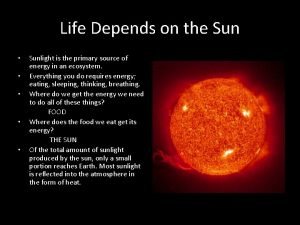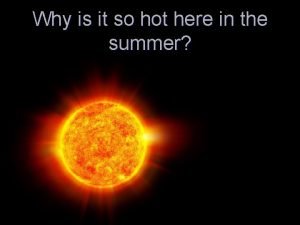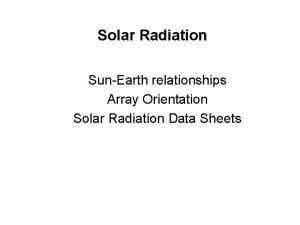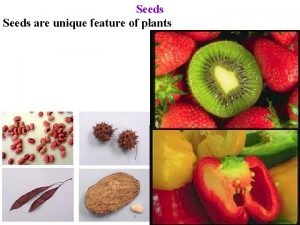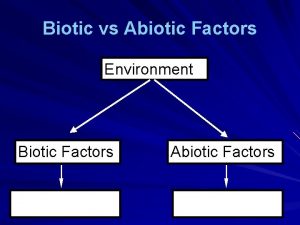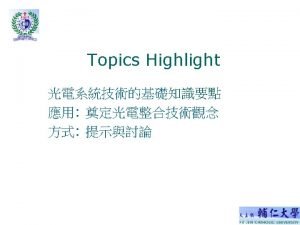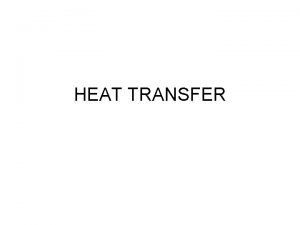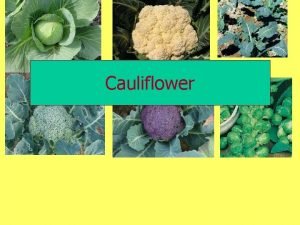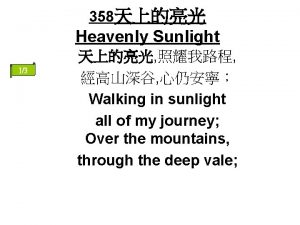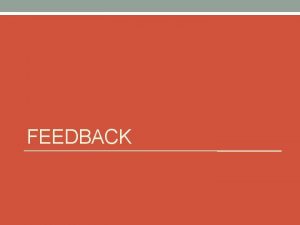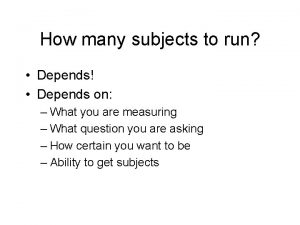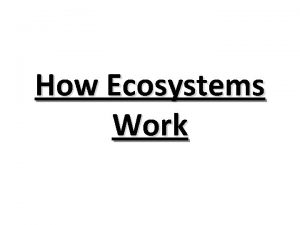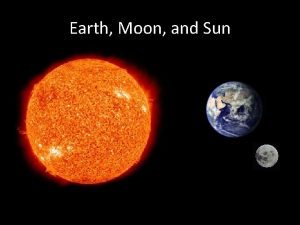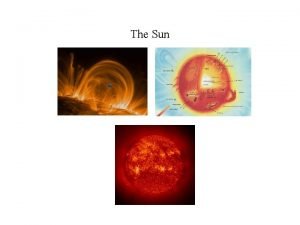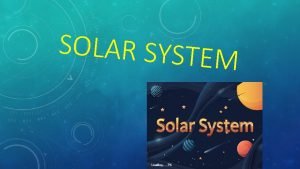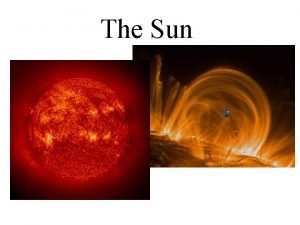Life Depends on the Sun Sunlight is the











- Slides: 11

Life Depends on the Sun • • • Sunlight is the primary source of energy in an ecosystem. Everything you do requires energy; eating, sleeping, thinking, breathing. Where do we get the energy we need to do all of these things? FOOD Where does the food we eat get its energy? THE SUN Of the total amount of sunlight produced by the sun, only a small portion reaches Earth. Most sunlight is reflected into the atmosphere in the form of heat.

Plants manufacture and store energy from the sun.

Photosynthesis: Plants Capturing the Sun’s Energy • Photo = light • Synthesis = putting together • Plants take in: • carbon dioxide (C 02) from the air • water (H 2 O) from the soil with their roots • Put it Together in the presence of light energy and chlorophyll to produce: • sugar (glucose C 6 H 12 O 6) • oxygen (O 2) • CO 2 + H 2 O chlorophyll C 6 H 12 O 6 + O 2 →→→→→→ light energy

Photosynthesis

People and animals eat plants to obtain energy

Some animals eat plant-eating animals to get their energy

This is called a simple food chain • A food chain shows the transfer of energy through an ecosystem. It always begins with the sun and plants. • The grass absorbs energy from the sun and stores it as usable food. The snail obtains energy from the grass and the sun. The bird gets energy from the sun, the grass and the snail. This is how energy flows through an ecosystem.

Decomposers • The food chain does not end with consumers : organisms that rely on plants for food. • The final stage is always the decomposers. • Carbon (C 2) and Nitrogen (N 2) are very limited and must be recycled back into nature for life to continue. • Carbon and Nitrogen are recycled back into the earth with the help of decomposers such as fungi and bacteria. • These organisms break down the complex molecules in dead plants and animals and change them into simple molecules that are used by other plants. • Carbohydrates found in dead plants and animals are reduced to CO 2 and H 2 O • Proteins broken down give off nitrogen

From Food Chain to Food Web • In an ecosystem there are many food chains. • In one way or another they interlock and cross over to form food webs. • See Handout “An Introduction to Food Webs” and “Food Webs”

A Review • Ecosystem: An area where biotic and abiotic factors interact with each other. • Biotic: The living organisms in an ecosystem. Example: plants, animals, fungi • Abiotic: The non-living factors in an environment. Example: wind, water, temperature, soil, rocks • Habitat: The physical place where an organism lives. • Niche: The ecological role of an organism. Example: Producer, consumer, decomposer • Producer: A living organism that makes its own food. Example Green plants • Consumer: • Any organism that uses rather than produces food. Example: people, cows, bears, lions etc.

Review Continued • Decomposer: An organism that breaks down the substance of dead organisms. Example: mushrooms, bacteria • Scavenger: An animal or insect that feeds on the remains of dead animals. Example: vultures and ants • Chlorophyll: The green coloring in plants that allows them to use energy from the sun as food. • Photosynthesis: The first step in any food chain. The food making process of green plants. • Food Chain: The transfer of feed energy from one organism to another. • Food Web: A group of interlinked food chains.
 Life depends on the sun
Life depends on the sun Earth's revolution
Earth's revolution Solar system
Solar system Hours of sunlight map
Hours of sunlight map Seed maturation
Seed maturation Siklus hidup produk kfc
Siklus hidup produk kfc Biotic and abiotic factors
Biotic and abiotic factors Lux0
Lux0 Sunlight melts a wax crayon left outside.
Sunlight melts a wax crayon left outside. Preventive of curds from direct sunlight is known as
Preventive of curds from direct sunlight is known as Raindrops sunlight and refraction lyrics
Raindrops sunlight and refraction lyrics Beauty poem class 6 word meaning
Beauty poem class 6 word meaning
